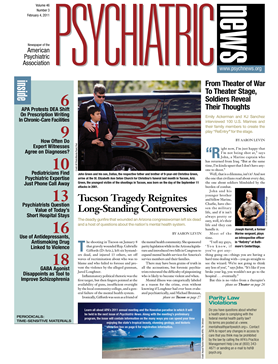Generalized anxiety disorder (GAD) is a chronic and debilitating illness demanding prolonged treatment, experts on the subject agree. But how long should patients receive treatment?
For at least a year, a study published in the December 2010 Archives of General Psychiatry suggests. It was led by Karl Rickels, M.D., a professor of psychiatry at the University of Pennsylvania.
During the first phase of the study, 158 subjects with GAD were treated with an SNRI for six months. The SNRI selected was venlafaxine XR because, as the researchers wrote, “it was the first antidepressant approved by the Food and Drug Administration (FDA) for the treatment of GAD.”
Of the 158 subjects, 136 who had improved clinically after six months of treatment—that is, had achieved a score of 1 or 2 on the Clinical Global Impressions scale—were enrolled in a second phase of the study, which also lasted six months. During this time, 82 of the subjects received venlafaxine XR again and 54 a placebo.
At the end of this period, only 10 percent of subjects taking venlafaxine XR had relapsed, while 54 percent on the placebo had—a highly significant difference. (Relapse was defined as meeting symptom criteria for a Structured Clinical Interview for DSM-IV GAD diagnosis and having a Clinical Global Impressions scale score of 6 or 7.) So it looked as if GAD patients would do best if they remained on venlafaxine XR for at least a year.
But the researchers conducted yet a third phase of the study to see whether this was actually the case.
Fifty-nine of the 136 subjects who were clinically improved at 12 months—that is, had a score of 1 or 2 on the Clinical Global Impressions scale—were enrolled in this phase, which lasted for six months.
These subjects were randomized to one of three groups. One group continued to get venlafaxine XR for the entire 18-month study period. The second group, which had received venlafaxine XR for 12 months, got a placebo during the six subsequent months. And the third group, which had received venlafaxine XR during the first six months, got a placebo for the subsequent 12 months. Results for the three groups were compared.
The relapse rates for the three groups were 7 percent, 32 percent, and 20 percent, respectively.
Finally the researchers compared results from the second phase of the study—where relapse rates were 54 percent for subjects who had received venlafaxine XR for six months and who had then been switched to a placebo for six months—with results from the third phase of the study—where relapse rates were 32 percent for subjects who had received venlafaxine XR for a 12-month period.
So putting these results together, it looks as if treatment of GAD with venlafaxine XR should be continued for at least 12 months, Rickels and his colleagues concluded. Or as Rickels told Psychiatric News, “Long-term treatment of GAD patients, that is, treatment for at least one year and not just two to three months is strongly recommended to guarantee high remission and low relapse rates. It is our belief that similar results could be expected also with other antidepressants.”
After study procedures were completed, the researchers offered venlafaxine XR for six months to the subjects who had relapsed after being switched from venalfaxine treatment to a placebo. Twenty-seven subjects accepted the offer. Preliminary results indicated that they again improved to the same degree as patients who had been on it for 12 months. “These results surprised us,” Rickels said. “If this finding can be repeated, it would mean that patients who are for at least six months on venlafaxine XR could go off medication until the symptoms return.”
The study was funded by the U.S. Public Health Service. Wyeth Pharmaceuticals provided the study medication.
